In 1929 the then director of the Tate Gallery, James Bolivar Manson, received a letter from a man called S.W. Cleveland, who was planning a lecture on ‘The Artist and Literature’.1 ‘Would you please tell me whether Rothenstein’s “Doll’s House” has any literary significance?’ he asked, noting that the painting ‘may have some connection with Ibsen but I cannot find any clear information on the point’. Cleveland’s confusion is not surprising: the relationship between the title of Rothenstein’s painting and its content has been a subject of contention ever since the painting was first exhibited. Despite Hubert Wellington’s insistence that The Doll’s House was ‘among the most purely pictorial in Mr. Rothenstein’s work’, the allusion to Henrik Ibsen’s play A Doll’s House (1879) has long raised questions as to whether the painting tells a story, and if so, what that story might be.2
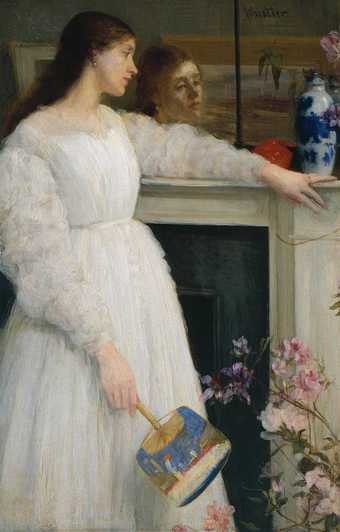
Fig.1
James Abbott McNeill Whistler
Symphony in White, No.2: The Little White Girl 1864
Tate
Photography © Tate 2016
The question of whether paintings could, or should, tell stories in the first place was hotly contested in the closing decades of the nineteenth century. As the art historian Pamela Fletcher has observed: ‘for Victorian audiences, the process of reading a painting was based on the expectation that a visual image could be translated into text … The process of reading began with the title and the accompanying text in the catalogue, which often provided a literary reference or created a story of its own.’3 Artists such as James McNeill Whistler had long railed against this, introducing titles that suggested a disregard for narrative and encouraged viewers to read the painting as interesting, primarily, for its aesthetic qualities (see, for example, Whistler’s Symphony in White, No.2 1864, also known as The Little White Girl, Tate N03418; fig.1). This challenge was taken up by the so-called New Critics of the 1890s, who viewed illustrative painting (in Fletcher’s words) as a ‘vulgar pandering to philistine middle-class taste’.4 This tradition of providing literary titles or references nonetheless proved hard to shift, even among artists who appeared to be following in Whistler’s footsteps, or who counted New Critics such as D.S. MacColl among their closest supporters.
The Doll’s House (fig.5) is a case in point. Rothenstein made no secret of his admiration for Whistler in the 1890s.5
The drawing of a woman leaning on a fireplace from his Paris sketchbook (1889–93) is surely intended as homage to Symphony in White No.2,6
while his 1894 painting Coster Girls (fig.2), with its Thameside setting and strident central figure, can be read as an updating of Whistler’s 1884 painting The Chelsea Girl (private collection), via Hogarth and Goya.7
The gestures of the two women in Coster Girls certainly hint at an intended narrative, with one contemporary critic going so far as to state that the
painting ‘tells its story plainly’.8
Exactly what this story was,
however, was never fully resolved, the title giving nothing much
away save the primary professional identity of the sitters.
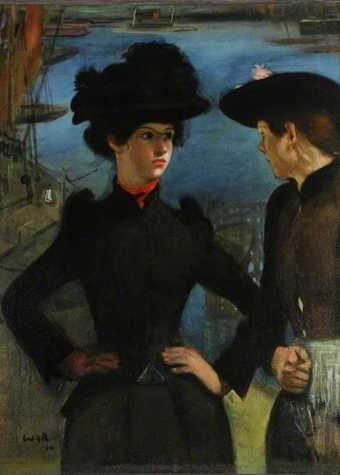
Fig.2
William Rothenstein
Coster Girls 1894
Museums Sheffield, Sheffield
Visually, The Doll’s House has many Whistlerian traits, with its low tones and hazy brushstrokes: details subordinate to mood and formal clout. It is not hard to imagine the painting being called Arrangement in Brown and Gold: Two Figures. Rothenstein, however, had other ideas. Whistler may have been more open to narrative readings of his art than he liked to suggest; it is unlikely, nonetheless, that he would have given one of his paintings a title such as this.9 By calling his painting The Doll’s House, a title that clearly derives from a work of literature, Rothenstein may well have been aligning himself with the very practice that Whistler sought to dismantle. Rothenstein’s appropriation of Ibsen’s play is not, however, as straightforward as it seems. In fact, Rothenstein’s use of narrative differs greatly from that of his Victorian forebears, establishing a highly complex and enigmatic relationship between text and image. The Doll’s House destabilises the tradition of Victorian narrative painting – exemplified by such works as William Quiller Orchardson’s The First Cloud 1887 (Tate N01520; fig.3) or Marcus Stone’s Il y en a toujours un autre 1882 (Tate N01583; fig.4), which also focus on the relationship between a young man and woman. Although viewers are not privy to any specific details, Orchardson and Stone’s paintings, with their directive titles, nonetheless leave little doubt as to what bothers the figures within them. The Doll’s House offers no such securities: it is instead one of a group of paintings that play with and ultimately subvert the genre of narrative painting, creating a category of its own, one which Fletcher has termed ‘anti-narrative’.10
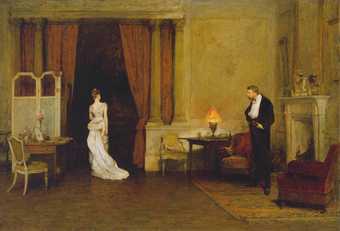
Fig.3
William Quiller Orchardson
The First Cloud 1887
Tate
Photography © Tate 2016
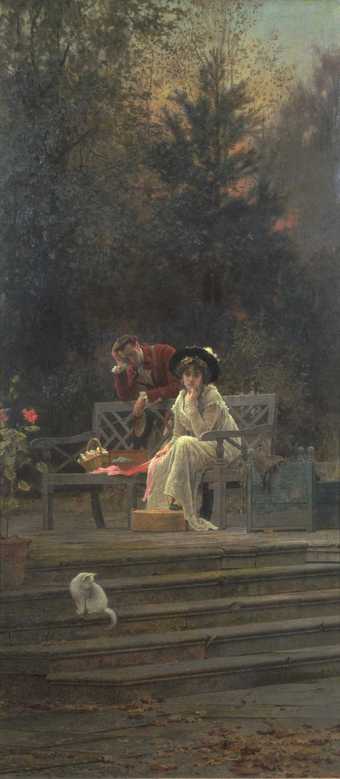
Fig.4
Marcus Stone
Il y en a toujours un autre 1882
Tate
Photography © Tate 2016
The initial and entirely justifiable reaction of first-time viewers is to presume that The Doll’s House is an illustration of Ibsen’s 1879 play. This prompts the question as to which scene it might depict. Two candidates have been put forward. The first suggests that the painting shows Nils Krogstad and his former lover Mrs Linde in a ‘moment of tension’ from act three of the play – a reading that has regularly appeared in catalogues published by Tate.11 The second, offered by Max Beerbohm, the writer, caricaturist and close friend of the artist, suggests the painting depicts the husband and wife Nora and Torvald Helmer in an unspecified scene.12 Beerbohm’s reading, offered in 1903, starts off unequivocally, describing the painting thus: ‘Nora, in a night-gown, crouching on a narrow staircase, while Helmer, in costume of 1830, stares sombrously out at us, with his back set against a damp discoloured wall’, before concluding that the painting offers viewers ‘more or less exactly the impression of Ibsen’s meaning.’ The phrase ‘more or less exactly’ carries a lot of weight; it is, in effect, Beerbohm’s admission that there will always be some sort of disjunction between the textual source and the painted image.
Despite the fact that he and Rothenstein were good friends, and would surely have shared their thoughts on the painting, Beerbohm’s reading has never attracted any followers. Interestingly, two other figures who could also claim a particular closeness to the artist left two very different impressions. For instance, Augustus John, who had not only been present at the painting’s conception, but posed for it, chose in his account of the work to ignore Ibsen entirely, reading it as a personal narrative instead:
I am portrayed standing at the foot of a staircase upon which Alice has unaccountably seated herself. I appear to be ready for the road, for I am carrying a mackintosh on my arm and am shod and hatted. But Alice seems to hesitate. Can she have changed her mind at the last moment? But what could have been her intention? Perhaps the weather had changed for the worse and made a promenade inadvisable: but we shall never know. The picture will remain a perpetual enigma, to disturb, fascinate or repel.13
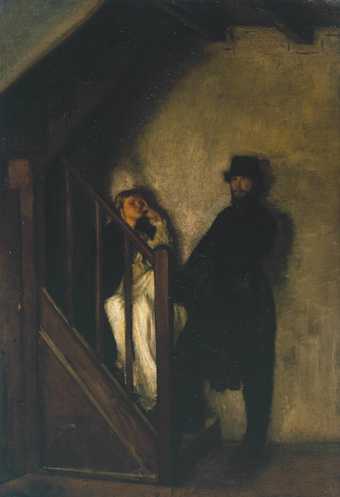
William Rothenstein
The Doll’s House 1899–1900
Tate
In John’s hands, the title of The Doll’s House is unimportant: the real drama lies elsewhere (fig.5). If he were instructed by Rothenstein to play the part of Krogstad or Helmer, he has forgotten the fact. He sees the painting as a representation of Alice and himself, not so much posed by the artist as captured in an accidental moment. Interestingly, the personal narrative he constructs is a rather mundane one about the weather, stripping the scene of any psychological or sexual tension. This is understandable: it would be strange if John, writing in the catalogue to his late friend’s memorial exhibition, were to draw attention to the curious fact of Rothenstein having painted his new wife in close proximity to a young artist whose virility was something of an open secret.14 John’s reading nonetheless reminds us that, for certain members of the painting’s audience, the identity of the models may have been as remarkable – or worthy of comment – as the reference to Ibsen. Anyone with a passing knowledge of Rothenstein’s art and of the British art world in general would have recognised this first and foremost as an image featuring Alice Rothenstein and Augustus John: a juxtaposition that may have encouraged narratives of its own, whatever the title of the painting.15
In his entry on his father in the Grove Dictionary of Art, William’s son John offered the following explanation for the painting: ‘the title [of The Doll’s House] refers to Ibsen’s play, yet the work has no particular theme, Rothenstein preferring to imply drama in the manner of Degas’s Absinthe’.16 Here Beerbohm’s suggestion is rejected in favour of something a little more vague. Again, one can only wonder whether John Rothenstein and his father ever talked about the painting together, or whether he arrived at this conclusion independently. It is interesting that the artist himself – who published three volumes of memoirs, wrote copious correspondence and lectured widely – consistently eschewed the many opportunities he was given to elaborate on the origins of the painting. Rothenstein had much to say about the art world in which he operated, and the people he met, but tended to remain tight-lipped on the subject of his own paintings. The Doll’s House merits only a passing mention in his memoirs, accompanied by a low-quality illustration.17 A couple of features – the staircase and Augustus John’s dress – are referred to, but he does not expand upon the reference to Ibsen. In one detail only does he seem to let something slip: the caption to the illustration in the memoirs reads ‘Augustus John and the Writer’s Wife (1899) “The Doll’s House”’, almost as if the Ibsen title had always been an afterthought and the painting had always been seen, primarily, as a portrait of Alice and John. This follows a general tendency in Rothenstein’s memoirs to refer to the models for his paintings, but not to any possible meaning. A similar thing occurs with Porphyria 1894 (fig.6), also known as Porphyria’s Lover, which takes its title from a poem by Robert Browning. The title is unequivocal in its relationship to a specific text; Rothenstein, however, recalls the painting thus: ‘I also painted Conder, reflected in a mirror, a canvas called Porphyria’s Lover. For the woman’s figure a beautiful girl, Miss Marion Gray, sat; she was sent to me by Oscar Wilde, and I did many drawings from her’.18 Browning is not even mentioned.

Fig.6
William Rothenstein
Porphyria (or Porphyria’s Lover) 1894
Mark Samuels Lasner Collection, on loan to the University of Delaware Library
Photography © Mark Samuels Lasner
It is easy to conclude from the foregoing that ambiguity was written into The Doll’s House from the start. If Rothenstein had intended something definite with his allusion to Ibsen he declined to state what this was, either from embarrassment (there is plenty of evidence that Rothenstein later regretted his excursion into literary titles) or as part of a deliberate strategy to keep the meaning open by actively encouraging viewers, friends and family included, to read the painting in a variety of ways.19
In light of this, most commentators now choose to follow John Rothenstein in describing the painting’s relationship with Ibsen’s play as a deliberately playful one. Pamela Fletcher has written that ‘the title, it seems, invokes the possibility of narrative meaning, but frustrates any attempt to pin that meaning down’, while the Tate Companion entry on the work written by the curator Emma Chambers in 2013 notes Rothenstein’s ‘refusal of a specific narrative’ while arguing that ‘The Doll’s House provides a visual equivalent for the brooding intensity of Ibsen’s play, and the playwright’s use of silence and atmosphere, in the way that it avoids dramatic incident but concentrates instead on its anticipation and the tense emotions that this prompts’.20 In this reading, the painting does not represent a scene from Ibsen, but an Ibsenesque moment. The title is a suggestion; drama is implied, as John Rothenstein noted, but not spelled out.
It is this denial of a specific narrative that allows the painting to qualify as an ‘anti-narrative’ painting, a type that was by no means particular to Rothenstein but can be seen in the work of many other contemporary artists, including John Collier, Walter Sickert and William’s younger brother, Albert Rutherston.21 These artists – under the influence of Edgar Degas and the debate surrounding the 1893 exhibition in London of L’Absinthe (Musée d’Orsay, Paris) – consistently produced works that represented contemporary experience, about which they seem to wish to tell a specific story, only to pull the rug out from under our feet.22 Missing clues or contradictions mean that the paintings, as Fletcher argues, ‘become about their own inability to tell a story’, leading viewers to the distinctly modern conclusion that human behaviour is essentially unknowable.23 Rothenstein, in this sense, invites us to penetrate John’s gaze in the confidence that he has made such a task impossible. There is no story here, at least not one that can be read in any straightforward sense. It’s as if a joke is being played on the viewer. This was very much the case, indeed, with Rothenstein’s friend and contemporary Walter Sickert, who not only took to giving his paintings misleading titles but also to changing those titles on a whim. This is seen to particularly good effect in his 1908 painting The Camden Town Murder (Yale Center for British Art, New Haven), also known as What Shall We Do about the Rent?, titles which suggest two different narratives for the same painting and neither of which completely resolve the visual clues offered by the painting itself. Just as The Doll’s House does not pretend to actually represent two figures from Ibsen’s play, so a painting such as Sickert’s La Hollandaise c.1906 (Tate T03548; fig.7) probably borrows its title from one of French writer Honoré de Balzac’s characters yet does not appear to be a portrait of the woman in Balzac’s novel.24 The connection is suggestive, perhaps even an afterthought.
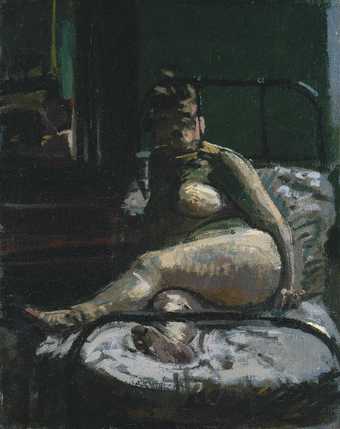
Fig.7
Walter Richard Sickert
La Hollandaise c.1906
Tate
Photography © Tate 2016
The same strategy is also at work in James Pryde’s projected series of twelve paintings entitled The Human Comedy (of which the first was The Doctor, Tate N05172; fig.8) which takes Balzac, once again, as its reference point, but is not remotely illustrative.25 Pryde’s series acts independently of its literary allusion. The ominous, almost melodramatic mood is Balzacian, as is the artist’s over-reaching ambition, but the actual subject of the paintings cannot be found in any of Balzac’s writings.26
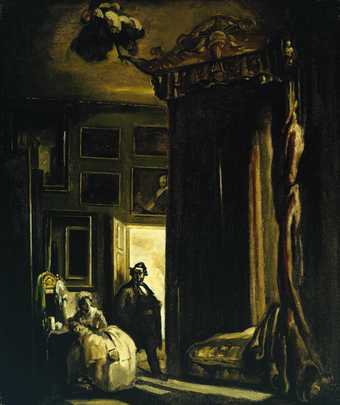
Fig.8
James Pryde
The Doctor exhibited 1909
Tate
Photography © Tate 2016
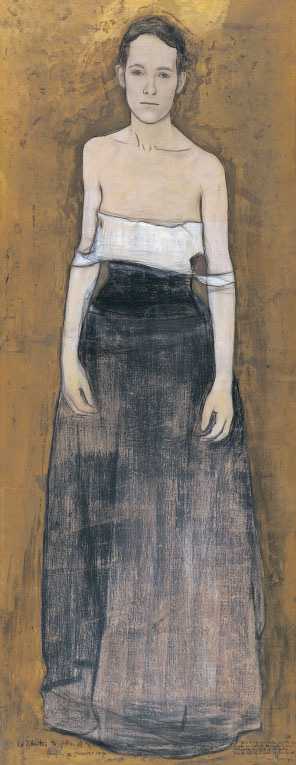
William Rothenstein
Parting at Morning 1891
Tate
Rothenstein’s ambiguous use of a literary source in The Doll’s House was by no means his first experiment of this kind. Throughout the 1890s, and a little beyond, Rothenstein consistently turned to literature as an influence on, or mood-setter for, his paintings. This practice clearly started early: literary allusions are sprinkled throughout his Paris sketchbook.27 More often than not, however, Rothenstein’s uses of literature serve to obfuscate rather than unlock narrative readings of his work.28 At least four of them, for instance, have a direct relationship with Robert Browning, but all of these require a certain amount of ‘teasing out’ on the viewer’s part. Parting at Morning 1891 (Tate T07283; fig.9) is the only work to contain an actual inscription – albeit a slightly misquoted one – from the poet, although Rothenstein’s response to Browning’s four-line poem is imaginative as opposed to strictly descriptive.29 Although the bronze background suggests the ‘path of gold’ in the poem, the imagery of the opening two lines is completely ignored. When one of these lines is taken up, in the title of a later landscape, Round the Cliff on a Sudden Came the Sea c.1908 (private collection), human content has been reduced to a couple of indistinct figures wandering on the cliff. In neither case do we feel as though Rothenstein is responding directly to Browning, but that the mood of the poem was simply one of many stimuli.
Porphyria (fig.6) seems, at first, to deviate from this rule. The woman’s costume, after all, is consistent with the setting of Browning’s poem and the painting certainly seems to suggest a specific narrative. However, as in The Doll’s House, there is no direct relationship between what is going on in the canvas and what is going on in the poem. Once again, as the literary historian Rowena Fowler has pointed out, Rothenstein uses the title as a ‘point of departure for a completely new work … a painting which aimed at achieving some equivalent, but separate, mood.’30 On occasion this equivalent mood can be almost impossible to fathom. What is the relationship, for instance, between Rothenstein’s 1902 interior, Flower, Fruit and Thorn Piece (fig.10) and Jean-Paul Richter’s 1796 novel Flower, Fruit, and Thorn Pieces; or, the Married Life, Death, and Wedding of Siebenkäs, Poor Man’s Lawyer? Was the image sparked by something in the text, or did Rothenstein just happen to be reading Richter at the time? It may be that the title was appropriated because Rothenstein liked the sound of the phrase, or perhaps there was some reference being made to Rothenstein’s German roots (he had just returned from a trip to Germany in 1902). What is known is that this is one of at least two paintings with literary titles that Rothenstein choose to rename at a later date. An inscription on the frame reads ‘Interior (formely Flower, Fruit and Thorn Piece)’, a fate the painting shares with Le Grand-I-Vert 1899 (fig.11), one of the other paintings started on the original trip to Vattetot.
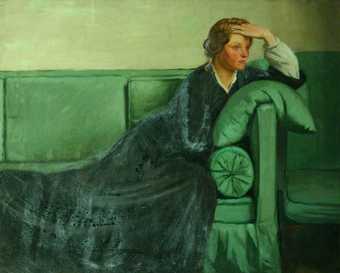
Fig.10
William Rothenstein
Flower, Fruit and Thorn Piece (also known as Interior) 1902
Oil on canvas
598 x 750 mm
Manchester City Galleries, Manchester
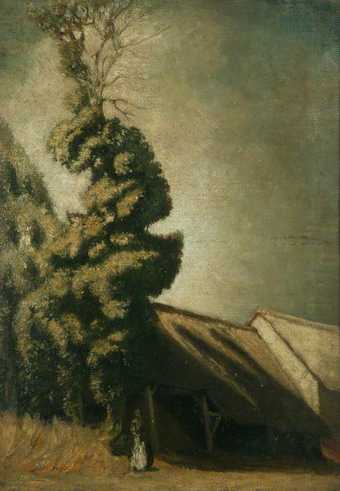
Fig.11
William Rothenstein
Le Grand-I-Vert 1899
Manchester City Galleries, Manchester
Le Grand-I-Vert (literally, ‘The Big Green I’) refers to a disreputable tavern that appears in Balzac’s novel Les Paysans 1844. The reference point, in this case, is an especially obscure one, and it is certainly worth questioning how many viewers of this painting would have recognised it. Those who did, conversely, may not have gained much from their knowledge: the building in the painting, after all, looks more like a barn than a tavern and the shadowy figures in the foreground are too indistinct to be recognised as characters from the novel.31 Of the three paintings Rothenstein started at Vattetot this is the painting that is hardest to read. Are there three figures or two standing and sitting on the bank? Is the faint red glow at the bottom right of the canvas evidence of a fire burning offstage? Although these details remain mysterious, they are not compellingly so. In the end it is the roughly painted tree or the stark sky that attracts viewers to this painting. In relabelling the painting Night, Rothenstein seemed to be admitting that the literary reference was no longer effective: that the painting worked better when presented purely as an atmospheric study, divorced from any possible narrative.
The Doll’s House, however, retained its title, perhaps because it referred to a commonly known and increasingly seminal text and because it had already gained a certain amount of fame under this name. It may also be possible that Rothenstein secretly enjoyed the confusion it created over the years, no doubt realising that, in some cases, uncertain literary significance can be as riveting as a well-told story. As Robert Speaight, Rothenstein’s biographer, concluded: ‘The Doll’s House suggests an anecdote and conceals a mystery; and the mystery is deeper than the anecdote – whatever the anecdote may have been’.32 Or, in the words of the critic C.L.H, writing in the Academy and Literature in April 1903: ‘Mr. Rothenstein’s “Doll’s House,” which means whatever you may like it to mean’.33
